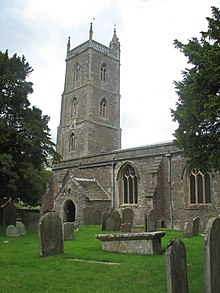
Nailsea is a town in Somerset, England, 8 miles (13 km) southwest of Bristol, and 11 miles (18 km) northeast of Weston-super-Mare. The nearest village is Backwell, which lies south of Nailsea on the opposite side of the Bristol to Exeter railway line. Nailsea had a population of 15,630 in the 2011 Census.

Wraxall is a village in North Somerset, England, about 6 miles (10 km) west of Bristol. Until 1811 the parish of the same name also included Nailsea and Flax Bourton. The village is now within the parish of Wraxall and Failand.

The Collegiate Church of the Holy and Undivided Trinity, Stratford-upon-Avon, is a Grade I listed parish church of the Church of England in Stratford-upon-Avon, Warwickshire, England. It is often known simply as Holy Trinity Church or as Shakespeare's Church, due to its fame as the place of baptism, marriage and burial of William Shakespeare. More than 200,000 tourists visit the church each year.
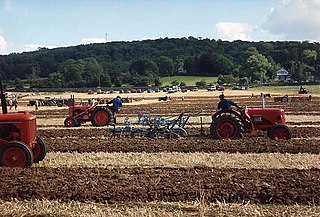
Brockley is a village and civil parish in Somerset, England. The parish is within the unitary authority of North Somerset, about 3 miles (4.8 km) south of Nailsea, and includes the village of Chelvey. According to the 2011 census it had a population of 277.
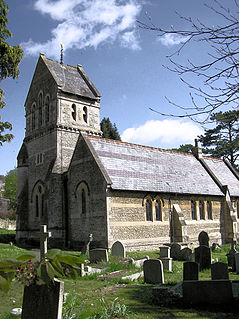
St Michael's Church is the Church of England parish church of Monkton Combe, Somerset, England. It was also the parish church of Combe Down until the 1850s when the communities separated. It is a Grade II listed building.

The Anglican Church of the Holy Trinity with St Edmund is a church on Wellington Hill, Horfield in Bristol, England. It has been designated as a grade II* listed building.

Holy Trinity Church is in Runcorn, Cheshire, England. It is an active Anglican parish church in the diocese of Chester, the archdeaconry of Chester and the deanery of Frodsham. Its benefice is combined with that of All Saints, Runcorn. It is recorded in the National Heritage List for England as a designated Grade II listed building.

Holy Trinity Church is in the centre of the town of Warrington, Cheshire, England. The church is recorded in the National Heritage List for England as a designated Grade II* listed building. It is an active Anglican parish church in the diocese of Liverpool, the archdeaconry of Warrington and the deanery of Warrington.

The Church of St John the Baptist, Frome is a parish church in the Church of England located in Frome within the English county of Somerset. It is a Grade II* listed building.
North Somerset is a unitary authority in the ceremonial county of Somerset, England. In the United Kingdom, the term listed building refers to a building or other structure officially designated as being of special architectural, historical or cultural significance; Grade I structures are those considered to be "buildings of exceptional interest". Listing was begun by a provision in the Town and Country Planning Act 1947. Once listed, severe restrictions are imposed on the modifications allowed to a building's structure or its fittings. In England, the authority for listing under the Planning Act 1990 rests with Historic England, a non-departmental public body sponsored by the Department for Digital, Culture, Media and Sport; local authorities have a responsibility to regulate and enforce the planning regulations.
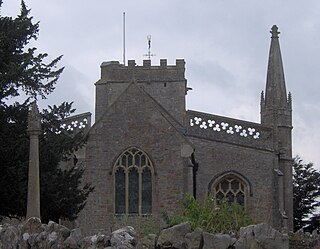
The Church of the Holy Trinity in Burrington, Somerset, England, is from the 15th century and was restored in 1884. It is a Grade I listed building.

The Church of the Holy Trinity in Street, Somerset, England, dates from the 14th century but underwent extensive restoration in the 19th century. It has been designated as a Grade I listed building.

Holy Trinity Church is a redundant Anglican church on Low Lane in the village of Wensley, North Yorkshire, England. The building is recorded in the National Heritage List for England as a designated Grade I listed building, and is under the care of the Churches Conservation Trust. Alec Clifton-Taylor included the church in his list of 'best' English parish churches.

St Margaret's Church, King's Lynn, entitled King's Lynn Minster since 2011, is a Grade I listed parish church in the Church of England in King's Lynn. The building dates from the 12th to 15th centuries, with major restoration of the nave in the 18th century. Five of its ten bells and its organ also date back to the mid-18th century.

Holy Trinity Church in Southport, Merseyside, England, is an Anglican parish church in the diocese of Liverpool and a Grade II* listed building. It was built in the early 20th century, and designed by Huon Matear in free Decorated style. It is constructed mainly in red brick, and has a tower, the upper parts of which are in elaborately decorated stone. Many of the internal furnishings are by the Bromsgrove Guild.
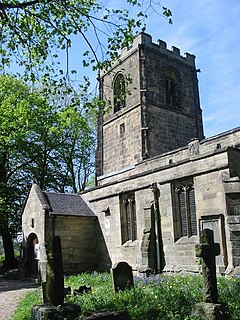
All Saints’ Church, Brailsford is a Grade I listed parish church in the Church of England in Brailsford, Derbyshire.

Holy Trinity Church, Micklegate, York is a Grade I listed parish church in the Church of England in York.

Holy Trinity Church is a Grade I-listed church in Marcross, a village in the Vale of Glamorgan, south Wales. It received its status as a Grade I-listed building on 22 February 1963.

Holy Trinity Church in Eccleshall, Staffordshire, England, is a Grade I listed Anglican church.

Holy Trinity is an Anglican parish church for Barnstaple in Devon. Dating from 1867 with an earlier tower from 1843 to 1845, the church comes under the Diocese of Exeter and has been a Grade II* listed building since 1981.
